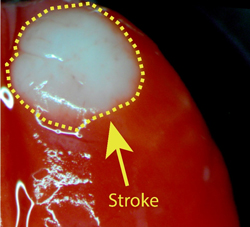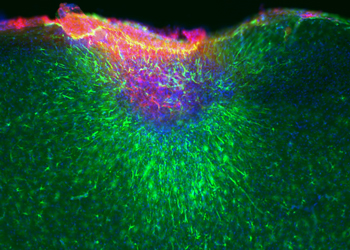Circadian rhythms in stroke pathology and recovery

Photothrombotic stroke as measured by TTC staining
Stroke is a debilitating disease, affecting over 1.5 million Americans a year. Interestingly, both stroke onset and severity fluctuate dramatically over the course of the day; the highest prevalence of stroke is observed in the morning hours, whereas stroke severity increases during sleep. The mechanisms responsible for these circadian (~24h) fluctuations in stroke onset and severity remain unclear. One candidate mechanism is glymphatic function. During an ischemic stroke event in the brain, neurons depolarize in a wave known as spreading depolarization initiating vasoconstriction, opening the perivascular spaces and allowing cerebrospinal fluid to rush in along the glymphatic system. Interestingly, glymphatic function has a circadian rhythm, increased during the sleep phase.
This goal of this research arm is to utilize circadian and glymphatic biology to test whether circadian clocks are necessary for normal glymphatic function, protect against stroke pathology, and can be reinforced to improve tissue recovery after stroke.

Glymphatic influx (red) into a 2-week old stroke-induced glial scar (GFAP staining, green; DAPI, blue)